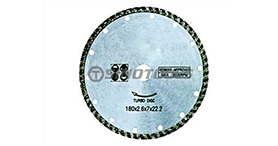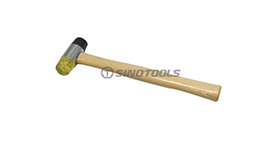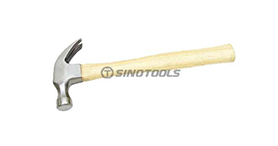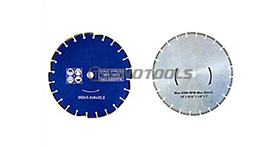■Dado saw blade
Table saws (and some rocker saws) can use the combined stacked dado kit.
For cutting 7/8" wide single-lane wall panels (skirts), grooves and notches, depending on the machine. These kits include two external cutting blades (one with left helical teeth and the other facing right Oblique teeth) and internal saw blades (with flat top teeth). Stack any combination of internal saw blades between the external saw blades to obtain the required passing width.
■Aperture
The size of the hole in the center of each circular saw blade matches the saw shaft (saw blade driveshaft). Most blades with a diameter of 10 inches or smaller are mounted on a 5/8-inch saw shaft, but 12-inch blades use a 1-inch saw shaft. If the saw shaft and the inner hole of the saw blade do not match, you need to use a reducing ring to reduce the diameter. This is due to the different table saw shaft standards in Europe and the United States. North America often uses inch shaft diameters, and the EU often uses metric systems. Shaft diameter size, and because of the difference in the standards they define for table saws, there will be different shaft sizes such as 15.875mm, 25mm, 30mm, etc. In China, because sliding table saws, circular saws, etc. often adopt European standards, our market The saw blades that are purchased are usually 25mm and 30mm shaft holes.
■Saw Blade Coating
Some saw blades have so-called coatings on the substrate, such as titanium plating, nitride black, chromium nitride color, etc., such coatings are designed to reduce friction, rust, and resin accumulation. Of course, some special saw blades are coated with metal or PTFE to resist the deformation of the saw blade substrate, maintain the hardness of the saw blade, and prevent heat generation. This kind of coating can effectively protect the saw blade and eliminate sawdust in time. The high-quality coating keeps the saw blade sharp for longer and consumes less energy. There are two different types of coatings that can be used for saw blades, one for the saw blade substrate and the other for the saw teeth. When the saw blade has two types of coatings, they will be different coatings because they achieve different purposes.
The saw blade substrate is coated with a protective layer to prevent rust or friction. Modern metal processing has developed a variety of manufacturing methods and used different alloys in the casting process to improve durability. The type of coating depends on the hardness of the metal making the saw blade, the rake angle, the back angle (clearance angle), tooth shape design, bonding material, and general-purpose. Some manufacturers paint saw blade substrates, mostly blue, red or orange, to provide brand recognition, but they can still provide rust-proof boards. Some high-cost saw blades are coated with polytetrafluoroethylene (PTFE) to reduce friction. This type of coating can be very valuable because the greatest friction comes from the debris clamped between the saw blade plate and the material being cut. By coating the saw blade substrate, these fragments will not stick to the saw blade. In addition, sometimes the material will squeeze the saw blade, even if the saw blade substrate is thinner than the teeth, especially for hand-held circular saws and electric saws.
The serrated coating is an important part of extending the life of the saw blade. Wood products are highly fibrous and tend to dull any saw blade. When cutting hard materials such as composite materials or plywood, the temperature is easily close to the melting point. This requires additional overheat protection. The harder the material used on the teeth, the longer the blade will last without dulling the teeth. Therefore, some extremely hard materials are used to cover the serrations.
Carbide serrations can also be improved by coating. Tungsten, titanium, cobalt, or vanadium can be electroplated on the cemented carbide to increase its surface hardness, reduce serration wear, and maintain sharpness for longer. The material can be identified by the color of the saw blade. In addition to permanent sharpness, this coating also has the characteristics of clean cutting, has a certain anti-corrosion performance, and will not damage the internal structure of the metal. The only disadvantage of carbide saw blades is that the coating is lost after re-sharpening.

Circular Saw Blade
■Expansion tank
In addition to the saw blade coating, in order to release the residual welding stress of the saw blade, eliminate the expansion of the saw blade body and reduce chattering, the lines and holes cut by the laser and the expansion grooves, vibration holes, etc., are well passed through the air. Convection measures to eliminate the heating of the saw blade, of course, also have the effect of reducing vibration and noise. Some saw blades are also filled with soft metal in the grooves and pores as a means of damping. These are the saw blade protection measures developed by saw blade manufacturers.
The expansion slot is a laser cutting slot, you can also call it an expansion joint, designed to disperse heat and prevent the saw blade from overheating and deforming. The sawing process will cause a lot of friction even under ideal conditions. When the teeth of the saw blade remove material, they are also rubbing the sides of the saw blade. The tooth tip rubs against the material on the cutting path. This friction can generate amazing heat, enough to scorch wood and even twist saw blades. The saw blade is quite hot even after cutting; when trying to remove the saw blade from the table saw, tap it with your hand and it will be easily burned. The best way to avoid burns is to cool down after shutdown. However, this does not solve the problem of overheating.
As the temperature of the metal increases, the metal shows a tendency to expand. The temperature of the saw blade is usually not uniform on the saw blade, forcing it to expand unevenly. Generally speaking, the saw blade substrate is hotter than the saw teeth, although the saw teeth are experiencing most of the friction. Even though the sawtooth has the greatest friction, it can be cooled by air movement. Therefore, when the saw blade substrate expands, it needs to be released. The outer edge of the saw blade substrate, where the saw teeth are attached, is not so hot, so there is no such big expansion. The saw blade substrate is deformed to the side, which is the cause of warpage. Saw blade warping becomes a waste product, so it is necessary to prevent them from expanding unevenly to avoid the risk of warping. One method is to use high-density alloys in the saw blade substrate. The other is to cut expansion grooves on the saw blade substrate by laser. Allow the saw blade to expand "inside". Although these cut grooves seem to be for artistic decoration, they can absorb the metal expansion and prevent warping of the saw blade.
Finally, to explain the knowledge of the saw blade thoroughly, we need to further explore the knowledge points of speed, noise, feed rate, tooth gap, sawing ability, substrate material, sawtooth shoulder, and so on. However, I think for beginner woodworking enthusiasts, the above ten points are enough to help you correctly understand the saw blade, choose the saw blade and use the saw blade. We are a China Circular Saw Blades supplier, if you are interested in our products, please feel free to contact us.



